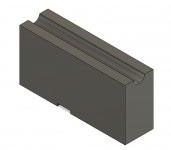Passmethehammer
Plastic
- Joined
- Feb 24, 2021
Hello.
New to this forum, hoping for enlightenment.
I make tube draw bending pressure and clamp dies for round tube up to 76mm (3 in) OD. They can be up to 500mm long. I currently 3D mill them, roughing with a flat end mill and finishing with a ball end mill, passing along the length with 0.05mm stepdowns. Then hand finishing the stepover, which can be laborious. This works for us, accurate enough, requires minimal setup/tooling investment and can just be left while I do something else.
I appreciate this isn't the correct way to do these to get a perfect half circle with minimal post machining finishing.
Ways I can think of:
Boring on the lathe
Boring on a horizontal borer
Boring vertically on a mill (end mill or boring head)
Right angle attachment on mill (end mill or boring head)
Horizontal mill with a convex cutter
Milling with large correct size ball end mill
Form grinding wheel (for smaller sizes only)
Each have their drawbacks but maybe a selection of the above are needed given the length, OD of tube and other dimensions - width etc (pressure die will be wider than clamps)
Can someone tell me (maybe with experience in tube bending tool making) their method for doing these. Are there any ways that I havent thought of that would work better? We have a 3-axis CNC mill and 2-axis CNC lathe.
Thanks.
New to this forum, hoping for enlightenment.
I make tube draw bending pressure and clamp dies for round tube up to 76mm (3 in) OD. They can be up to 500mm long. I currently 3D mill them, roughing with a flat end mill and finishing with a ball end mill, passing along the length with 0.05mm stepdowns. Then hand finishing the stepover, which can be laborious. This works for us, accurate enough, requires minimal setup/tooling investment and can just be left while I do something else.
I appreciate this isn't the correct way to do these to get a perfect half circle with minimal post machining finishing.
Ways I can think of:
Boring on the lathe
Boring on a horizontal borer
Boring vertically on a mill (end mill or boring head)
Right angle attachment on mill (end mill or boring head)
Horizontal mill with a convex cutter
Milling with large correct size ball end mill
Form grinding wheel (for smaller sizes only)
Each have their drawbacks but maybe a selection of the above are needed given the length, OD of tube and other dimensions - width etc (pressure die will be wider than clamps)
Can someone tell me (maybe with experience in tube bending tool making) their method for doing these. Are there any ways that I havent thought of that would work better? We have a 3-axis CNC mill and 2-axis CNC lathe.
Thanks.


